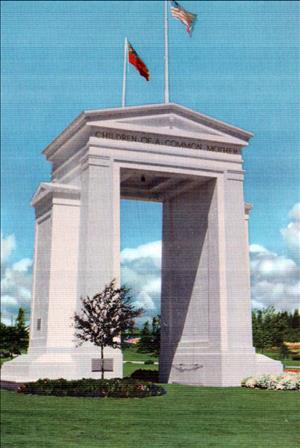On August 17, 1947, the Puget Sound Chess League and British Columbia Chess Federation square off at Peace Arch Park’s first international chess tournament. Peace Arch Park crosses the United States/Canadian border at Blaine. Five more matches at the park will follow in the 1950s, but the Washingtonians will not fare well, winning only two out of 12 matches played there.
International Chess Matches
“International chess matches” had been played intermittently in a friendly rivalry between British Columbia and Washington chess teams as far back as 1898. In 1944 a more regular schedule began, with a tournament played once each summer in Washington state or British Columbia. In 1947 the two teams met at Peace Arch Park.
To appreciate the tournament’s significance to chess players -- and for that matter others who were interested (The Seattle Times wrote two different articles that discussed the 1947 tournament and two more articles announcing it) -- you have to look at the event through mid-twentieth century eyes and not through twenty-first century eyes. Transportation in the 1940s and 1950s was more limited, and communications were far more limited, than what we have now (2011). So while the match might seem like no big deal today, in the 1940s it was a big deal indeed. People planned for it for weeks, and many men came to the 1947 tournament in suits and ties.
All the written accounts of the tournament say that rows of tables were set up through the park along a white tape marking the boundary line, with American players seated in the United States and Canadian players seated in Canada. But none of the written accounts this writer has seen address a picture of the 1947 match that clearly shows players at a row of tables that are not on the boundary line but instead are set up perpendicular to it in front of the Peace Arch, with the tables running right through the arch’s portal. Why was this?
Blowout and Fadeout
The match was played under sunny skies on Sunday, August 17, between 166 contestants -- 83 American, 83 Canadian. American players wore tall stars-and-stripes red, white, and blue top hats, while the Canadians sported rather large, broad-brimmed helmets. And while the competition was serious business, other players came just to have fun. One Seattle player, Richard Allen, came with a game that he introduced as “super chess,” with a chess board made up of 12 rows and columns for a total of 144 squares (a normal chess board is 8 rows and columns for a total of 64 squares). In Allen’s game there were not one but two players per side, and they loudly and shamelessly teased and mocked each other while battling for dominance on the chess board, in stark contrast to the staid silence in a traditional chess match.
Good thing the Americans enjoyed themselves, because its A team lost to the Canadians by a final score of 16.5 to 13.5. (Two games were still tied at the end of play on Sunday and were carried over until Monday. The Americans won both of them.) But the allegedly less-strong B team fared better and won solidly, though accounts of the final score differ. Washington players came from the Seattle Y.M.C.A. Chess Club and other Seattle-area chess clubs, as well as chess clubs from Everett, Whidbey Island, Tacoma, and Olympia; B.C. players came from Vancouver, Chilliwack, Haney (now part of Maple Ridge), and Mission City (now Mission).
Five more tournaments were held at Peace Arch Park every other year between 1951 and 1959. The Americans didn’t fare well, particularly later in the 1950s when they began having trouble attracting enough players to put on a strong performance. Of the six matches played at the park, America’s A team only once took home the winner’s trophy (a miniature replica of the Peace Arch), in 1953. Likewise, 1947 was the only year the American B team won at the park (although in fairness, in 1955 it maneuvered the Canadians to a tie, but B.C. was awarded the match by default).
In 1959 the park hosted its final tournament at the Canadian kitchen in the park’s northwest corner. Interest continued to fade in the 1960s, and the last match between the teams was played in White Rock, B.C., in 1963. Today a version of these games exists as scholastic matches played by students from each grade from kindergarten through 12th grade.

